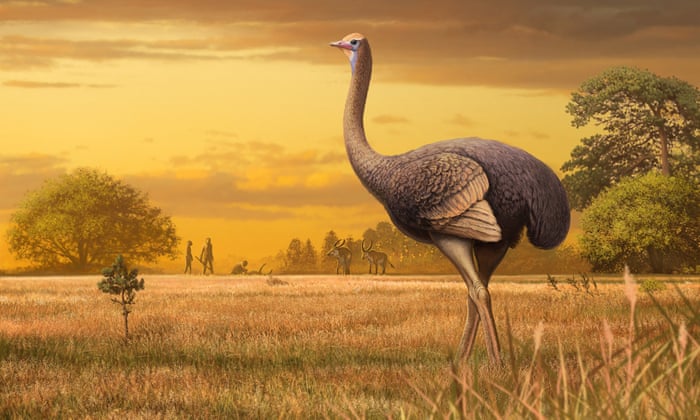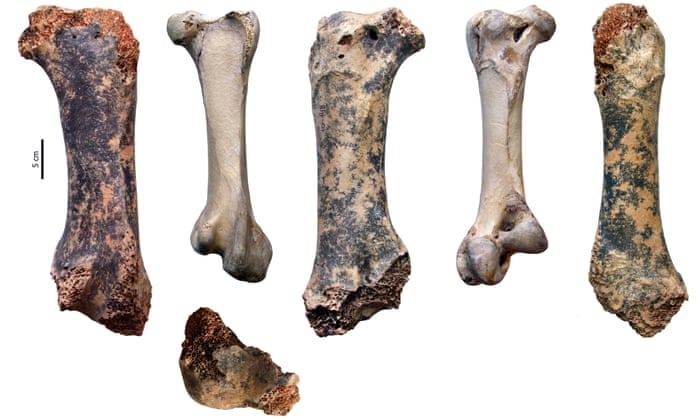Half-tonne birds may have roamed Europe at same time as humans
Huge thigh bone in Crimean cave belonged to largest bird found in northern hemisphere

An artist’s impression of the giant bird whose remains were found in a Crimean cave. Photograph: Andrey Atuchin

Analysis of the 40cm-long bone and others found with it date the remains to between 1.5m and 1.8m years old, suggesting the birds may have been part of the local wildlife when Homo erectus, an ancient ancestor of modern humans, reached Europe 1.2m years ago.
The enormous birds may well have been a valuable source of meat, bones, feathers and eggshells for the early human settlers, the scientists say.

The giant bird’s bones (left, middle and right) alongside those of an ostrich. Photograph: Nikita Zelenkov/Society of Vertebrate Paleontology
Nikita Zelenkov, a palaeontologist at the Russian Academy of Sciences, said that when he first received the thigh bone for study he thought it must be from a long-extinct elephant bird from Madagascar. “No birds of this size have ever been reported from Europe,” he said.
But close inspection revealed that the bird probably belonged to an ancient species called Pachystruthio dmanisensis, a stocky, flightless creature that stood about 3.5 metres tall. Based on measurements of the thigh bone, the scientists calculate the bird weighed about 450kg, which is twice the weight of the largest extinct moas from New Zealand, three times heavier than the largest living bird, the common ostrich, and nearly as heavy as an adult polar bear. The fossils are described in the Journal of Vertebrate Paleontology.

“We don’t know when it became extinct exactly, but most likely it did not survive later than 1.2m years ago,” Zelenkov said. “They would have been seen by various Homo erectus people.”
Despite the bird’s bulk, the long, slim thigh bone shows it was fast on its feet. Other remains recovered from the cave offer some explanation as to why that may have helped: the giant bird lived alongside some of the most formidable predators of the Ice Age, from sabre-toothed cats to other over-sized carnivores, including giant cheetahs and giant hyenas. All could take on prey as large as mammoths.
Evolution has decorated the tree of life with a bizarre collection of bulky birds. The apparently herbivorous Gastornithidae, a family of prehistoric flightless birds with powerful legs and enormous beaks, stalked Europe, Asia and North America, from 66m to 35m years ago. When fully grown, some species reached three metres tall.
A similar-sized feathery beast brought terror to the rainforests of Australia’s Northern Territory 15m years ago. Technically known as Bullockornis planei but named the “demon duck of doom” by a researcher with an eye for publicity, the bird sported a scythe-like beak on a head the size of a horse’s. Also known as thunderbirds, the beasts are thought to have survived until at least 50,000 years ago.
Scientists have argued over the identity of the world’s largest bird for decades, but last year researchers at the Zoological Society of London attempted to settle the matter. They set out with a tape measure and a pair of callipers to measure hundreds of bird bones in museums around the world and came across one creature from Madagascar that stood three metres tall and weighed up to 800kg. Its name, Vorombe titan, means “big bird” in a mixture of Malagasy and Greek.
The Taurida cave where the latest bones were found was discovered only last year during the construction of a motorway that will link Simferopol, a city in the heart of the Crimean peninsula, to the city of Kerch in the east. How common the big birds were across Europe is unknown and a question that future expeditions will now seek to answer. “Although there is no evidence yet, this bird might have been spread across more western territories,” Zelenkov said.
Excavations at the site have also uncovered the remains of a bison and a mammoth, and field studies at the site are expected to continue for some time yet. “There may be much more that the site will teach us about Europe’s distant past,” Zelenkov said.
https://www.theguardian.com/science/2019/jun/27/half-tonne-birds-roamed-europe-humans

An artist’s impression of the giant bird whose remains were found in a Crimean cave. Photograph: Andrey Atuchin
Giant flightless birds that dwarfed modern ostriches and weighed nearly half a tonne roamed Europe when the first archaic humans arrived from Africa, scientists say.
Researchers unearthed the fossilised thigh bone of one of the feathered beasts while excavating a cave on the Crimean peninsula on the northern coast of the Black Sea. It is the first time such a massive bird has been found in the northern hemisphere.
Researchers unearthed the fossilised thigh bone of one of the feathered beasts while excavating a cave on the Crimean peninsula on the northern coast of the Black Sea. It is the first time such a massive bird has been found in the northern hemisphere.
Analysis of the 40cm-long bone and others found with it date the remains to between 1.5m and 1.8m years old, suggesting the birds may have been part of the local wildlife when Homo erectus, an ancient ancestor of modern humans, reached Europe 1.2m years ago.
The enormous birds may well have been a valuable source of meat, bones, feathers and eggshells for the early human settlers, the scientists say.

The giant bird’s bones (left, middle and right) alongside those of an ostrich. Photograph: Nikita Zelenkov/Society of Vertebrate Paleontology
Nikita Zelenkov, a palaeontologist at the Russian Academy of Sciences, said that when he first received the thigh bone for study he thought it must be from a long-extinct elephant bird from Madagascar. “No birds of this size have ever been reported from Europe,” he said.
But close inspection revealed that the bird probably belonged to an ancient species called Pachystruthio dmanisensis, a stocky, flightless creature that stood about 3.5 metres tall. Based on measurements of the thigh bone, the scientists calculate the bird weighed about 450kg, which is twice the weight of the largest extinct moas from New Zealand, three times heavier than the largest living bird, the common ostrich, and nearly as heavy as an adult polar bear. The fossils are described in the Journal of Vertebrate Paleontology.
“We don’t know when it became extinct exactly, but most likely it did not survive later than 1.2m years ago,” Zelenkov said. “They would have been seen by various Homo erectus people.”
Despite the bird’s bulk, the long, slim thigh bone shows it was fast on its feet. Other remains recovered from the cave offer some explanation as to why that may have helped: the giant bird lived alongside some of the most formidable predators of the Ice Age, from sabre-toothed cats to other over-sized carnivores, including giant cheetahs and giant hyenas. All could take on prey as large as mammoths.
Evolution has decorated the tree of life with a bizarre collection of bulky birds. The apparently herbivorous Gastornithidae, a family of prehistoric flightless birds with powerful legs and enormous beaks, stalked Europe, Asia and North America, from 66m to 35m years ago. When fully grown, some species reached three metres tall.
A similar-sized feathery beast brought terror to the rainforests of Australia’s Northern Territory 15m years ago. Technically known as Bullockornis planei but named the “demon duck of doom” by a researcher with an eye for publicity, the bird sported a scythe-like beak on a head the size of a horse’s. Also known as thunderbirds, the beasts are thought to have survived until at least 50,000 years ago.
Scientists have argued over the identity of the world’s largest bird for decades, but last year researchers at the Zoological Society of London attempted to settle the matter. They set out with a tape measure and a pair of callipers to measure hundreds of bird bones in museums around the world and came across one creature from Madagascar that stood three metres tall and weighed up to 800kg. Its name, Vorombe titan, means “big bird” in a mixture of Malagasy and Greek.
The Taurida cave where the latest bones were found was discovered only last year during the construction of a motorway that will link Simferopol, a city in the heart of the Crimean peninsula, to the city of Kerch in the east. How common the big birds were across Europe is unknown and a question that future expeditions will now seek to answer. “Although there is no evidence yet, this bird might have been spread across more western territories,” Zelenkov said.
Excavations at the site have also uncovered the remains of a bison and a mammoth, and field studies at the site are expected to continue for some time yet. “There may be much more that the site will teach us about Europe’s distant past,” Zelenkov said.
https://www.theguardian.com/science/2019/jun/27/half-tonne-birds-roamed-europe-humans
Nenhum comentário:
Postar um comentário
Observação: somente um membro deste blog pode postar um comentário.